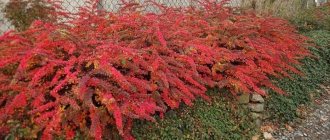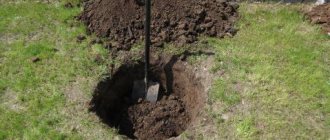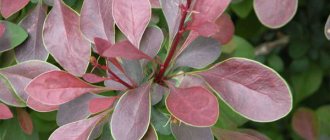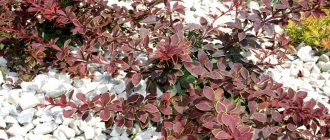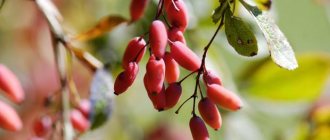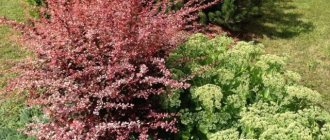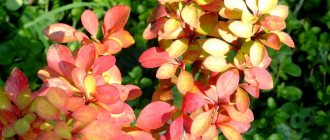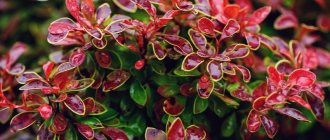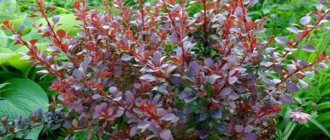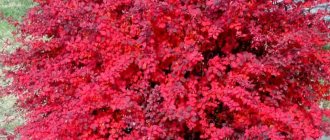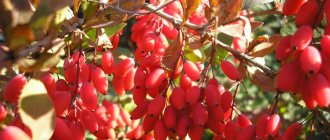Barberry (photo): planting and care in the country
Barberry is an ornamental and fruit shrub , barberry berries are living candies: they cool, sweeten and sour, in addition, they are used for making jams, preserves, compotes and tinctures. Juice from barberry berries has pronounced antibacterial and antipyretic properties. Barberry leaves are used for marinades; their infusion can be used as an anti-inflammatory agent for diseases of the biliary tract and liver.
Diseases and pests
Red Rocket is highly resistant to various diseases. However, there are some that can be dangerous for him. Fungal diseases such as powdery mildew, spotting and bacteriosis can lead to the death of the plant. Therefore, at the first signs of infection, barberry must be treated with fungicides.
Note! Among insects, the main pests for Red Rocket are the barberry aphid and the flower moth. Due to their actions, the leaves of the bush may dry out and the harvest may be lost. Treatment of the plant with a soap solution and spraying with insecticides will help combat them.
Types of barberry: diversity and attractiveness
Despite the fact that the barberry bush is quite a long-standing and well-known “guest” in our front gardens, it is now experiencing a new surge of interest in itself. Today, a wide variety of varieties of barberry have appeared: creeping forms are used to strengthen and camouflage slopes, pyramidal types are used to create coolers, and individual specimens with bright leaves are used for solitaire plantings.
Unopened barberry flowers
Of more than 170 types, we present the most popular:
- common barberry is a branched shrub that grows up to 3 m in height. The shoots are erect, abundantly strewn with thorns, the leaves are rich green . The flowers are bright yellow, collected in racemes, with a delicate honey aroma. In the first year, the branches are yellow or yellowish-purple, which in the second year change color to grayish - white . Fruiting is abundant, annual, the berries are bright red, edible, although species with yellow and even white fruits are cultivated. The species is perfectly adapted to urban conditions, tolerates numerous prunings, and is very frost-resistant. Undemanding to soil, not picky about lighting conditions, although it develops better in good lighting
- Thunberg barberry is a low (up to 1 m) deciduous shrub that thrives in the polluted atmosphere of a modern metropolis. Drought-resistant, not picky about soil composition. The leaves are small, oblong, graceful, reach a length of up to 3 cm, bright green, the lower part is gray, in the fall they change color to bright red, yellow, orange and even purple . Young shoots have an attractive color - purple-red, yellowish or bright red; with age they become brown or purple-brown.
- The branches are abundantly covered with hard (about 1 cm) thorns, so in landscape design this species is often used to create impassable hedges. And since the bush easily tolerates pruning, it is easy to maintain their correct shape. In addition, it is often used in Japanese and stone gardens , on the banks of reservoirs , and in landscape compositions. Flowering lasts 8-12 days, the flowers are single, reddish on the outside, yellow on the inside. In autumn, impressive-looking fruits appear - elliptical in shape, coral-red, shiny, but at the same time absolutely inedible
- Maria barberry is one of the many varieties of Thunberg barberry, with a dense columnar crown reaching a width of 50 cm. Shoots are straight, vertical, low-branched, can reach a height of 90-100 cm. Leaves are golden yellow, with carmine red edges border, in autumn they acquire an expressive bright orange-red color
Young barberry bushes Maria
- orange barberry - presented in two varieties. Orange Rocket attracts with its bright two-tone color - young leaves and shoots are orange, which “with age” become beet color, and with the onset of autumn they change color to red. Orange Dream is a low shrub with a spreading crown. It is especially good in the fall - its leaves turn bright red and do not fall off until frost. The bush is “blazing”, diluting the grayness of the pre-winter garden
Barberry Orange Rocket
Barberry Orange Rocket with lower leaves still green
Barberry Orange Dream
- Golden barberry will become a bright spot of sunshine on your site. This is a small (up to 50 cm in height, crown diameter does not exceed 1 m) bush with a cushion-shaped dense crown that remains attractive throughout the growing season. The color of the leaves depends on the degree of illumination and ranges from light green to golden yellow. Differs in very insignificant annual growth
Young golden barberry
- barberry Atropurpurea is a medium-tall (1.5-1.8 meters) shrub that retains spectacular, richly colored purple red-brown leaves throughout the season. Flowering occurs at the beginning of June and lasts, on average, 12 days. Propagates well - rooting of summer cuttings is almost 100%, seed germination is 90%
- barberry superba is a fairly large (can reach 4 m in height and diameter) ornamental shrub. In summer the leaves are dark red , with a bluish bloom; in autumn they change color to orange and bright red. The bright red berries that ripen in September and are densely distributed throughout the bush also add to the attractiveness of the bush. Flowering occurs in May, the flowers are red-yellow, collected in racemose inflorescences up to 5 cm long
- Rocket barberry is a purple-leaved, columnar variety with vertical shoots and short branches. Leaves are red-brown. Looks impressive when planted alone against a backdrop of bright greenery.
- barberry red - red-leaved varieties of barberries, which include Red Chief, Red Pillar, Red Carpet, etc.
Barberry Red Rocket: variety description
Berberis Thunbergii Red Rocket is a shrub belonging to the Columniaceae family. Although it is quite popular in many countries, it has not yet received proper distribution in Russia. Therefore, plant seedlings are difficult to find in stores, and they will be very expensive.
What does Red Rocket look like?
For your information! Due to its high frost resistance, Red Rocket is grown in many northern regions.
Red Rocket barberry has a vibrant appearance. Its leaves are elongated and large in size and change color depending on the intensity of light: from red-green to dark purple. Flowering occurs from early May to late June. The blossoming small buds of bright yellow color are collected in racemose-shaped inflorescences.
The shrub reaches a height of 2 m. It does not have developed branching, the crown rarely reaches a diameter of more than 1 m. The shoots grow vertically upward and have an oblong, elongated shape.
Important! It is worth remembering that the bush is quite thorny, so it is necessary to care for it with gardening gloves and thick clothing.
Barberry: planting and care
Despite the variety of barberry species and their differences, they all require the same planting and care conditions. First of all, you should take care of the illumination of the area - in order to get bright foliage of saturated colors, barberry must receive enough light . In partial shade, the brightness of color and varietal characteristics begin to be lost, all leaves acquire a greenish tint. The exception is the yellow barberry "Aurea", the leaves of which can burn in the sun, so it is preferable to choose partial shade for it.
Advantages and disadvantages of the variety
The main purpose of Thunberg barberry is to create spectacular compositions in gardens, parks and private areas. For this purpose, you can use any of its varieties - “Orange”, “Red”, “Golden” or “Rosie”, which have both common advantages and disadvantages.
The thorns of the Thunberg barberry "Rocket" interfere with weeding, pruning and harvesting fruits
The advantages of the varieties “Red”, “Orange”, “Golden” and “Rosie Rocket” include:
- unpretentiousness;
- highly decorative;
- adaptability to extreme weather conditions;
- resistance to frost in winter;
- easy tolerability of pruning;
- the possibility of forming a crown by cutting;
- versatility of use in landscape design;
- good immunity to diseases and pests;
- the presence of edible, healthy berries;
- pleasant aroma of blossoming inflorescences;
- characterized by a long flowering period (“Orange”);
- the foliage of the “Red” variety is unusually bright;
- "Golden Rocket" flowers in the form of bells;
- stands out for its variegated foliage (“Rosie”).
There are not many disadvantages to the varieties “Red”, “Orange”, “Golden” and “Rosie Rocket”:
- loss of brightness when planting in the shade;
- freezing of the tops in severe winters;
- prickliness;
- grows very slowly (“Orange”);
- does not tolerate excessive soil moisture (“Red”).
Reproduction
The plant must be at least 3–5 years old, and its root collar must be at a depth of at least 10 centimeters. In spring, the bush needs to be dug up, and then it is divided into several sections, which should be approximately the same in size. In order to divide the root itself, you may need not only pruning shears, but also a garden saw. Proceed with extreme caution, trying to cause as little damage to the plant as possible. When the bush is divided, all sections must be smeared with crushed charcoal, after which the sections are planted in open ground. In the case when the stems of a specimen begin to branch above the ground surface, this propagation method is not used.
Use in landscape design
Thanks to its spectacular appearance, Red Rocket is actively used by gardeners to create landscape design in their garden plots. The plant looks great both alone and in the company of other barberry varieties.
This type is used to create hedges, design alpine slides, and stone gardens. With its help you can create a unique design in your summer cottage.
Thus, Red Rocket barberry is worthy to become a real decoration of the site. With its help, you can create unusual compositions that will delight you with their appearance throughout the summer.
Barberry is an unpretentious shrub
Barberry is an interesting and useful group of shrubs that are often grown in gardens because of their attractive leaf color. Their flowers and fruits added to their popularity, as well as their hardiness, versatility and usefulness. Barberries can be grown in many different environments, even in pots and containers, so you don't need to have a garden to enjoy them on your deck, patio or balcony. Oriental lovers use barberry to create bonsai trees.
Edible species
No home garden is complete without fruit trees. Even the laziest gardeners plant their plots with raspberries, apple trees, and pears, but few people prefer such an unpretentious plant as barberry. In addition to its nutritional value, it is also worth noting its healing and decorative properties.
Common barberry
The most common barberry is in the Caucasus and Southern Europe, but it can also grow in Siberia. Shrubs of this species are frost-resistant and can withstand temperatures down to -35 degrees. The main condition for growing is to place the plants in sunny and dry areas. Planting in the shade negatively affects the taste and quantity of fruits.
Common barberry is one of the most common members of the family, which is distinguished by its unpretentiousness and high frost resistance.
The common barberry has quite a few varieties, namely:
- Lutea is a bush up to 2 m high with yellow shoots and light green foliage. The fruits are golden yellow and sour. It should be planted only in open sunny areas of the garden.
- Aureomarginata - can reach a height of 3 m, has very beautiful leaves, edged with a golden stripe. Very effective in hedges. The fruits are scarlet, tasty, sweet and sour, ripen in October.
- Atropurpurea - the height of the bush does not exceed 2 m, the shoots are purple with dark red leaves and fruits. A very impressive plant. Berry picking is carried out at the end of September - beginning of October.
- Alba variegata - this variety is valued for its high decorative properties. Its foliage is “painted” with white streaks, the color of the fruits is creamy white.
- Dulchiz - has all the species characteristics of the common barberry, and is distinguished by the high taste qualities of the fruit. The berries are sweet and fully ripen by mid-October.
- Asperma is a tall bush with red seedless berries.
Video: characteristics and beneficial properties of barberry
Amur barberry
Plants of this species are shrubs reaching a height of up to 3.5 m. The shoots have spines up to 2 cm long. Depending on the time of year, the color of the leaves may change, acquiring a reddish tint in the fall. In spring, small yellow flowers appear on the bushes with a pleasant aroma. In November, the flowers are replaced by bright red fruits.
Amur barberry is distinguished by abundant flowering and fruiting
There are two best known varieties of this species:
- Japonica - characterized by more rounded leaves and a small number of flowers on the racemes.
- Orpheus is a non-flowering variety bred by Russian breeders exclusively for decorative purposes. The height of the bush is 1 m.
Barberry spherical
This type of barberry grows in Central Asia, Mongolia and China. It is its fruits that are included in traditional Asian dishes such as lagman, shurpa and pilaf. The shrub can reach up to two meters in height. The shiny reddish shoots are covered in showy dark green leaves in spring. The yellow-orange inflorescences bloom in early June and have a distinct aroma. The fruits are painted black, covered with a bluish coating on top.
The spherical barberry is not very adapted to the climatic conditions of Russia. If you decide to plant this shrub in your garden, make sure you have good shelter.
The fruits of the spherical barberry have excellent taste.
The danger of spreading wild barberry
In recent years there has been concern about the spread of wild barberry in some areas. The seeds are carried by birds, which is why plants can often be found in abandoned fields, growing along roads and ditches, and in natural forests. But hybrid varieties are practically not propagated in this way, so they can only be purchased in nurseries. In this sense, barberries are safe for the environment; there is no need to be afraid to grow them on your own plots.
Barberry Thunberg: a vibrant shrub for any garden
There are several attractive and hardy species that do not require much care. Among these plants is decorative barberry. One of the most popular species is Thunberg barberry, which is resistant to most diseases and can grow even on rocky soils. This bush comes from Asia, where it grows in mountainous areas. The peculiarity of the plant is its high decorative value, a huge number of different varieties and an unusual crown shape.
Barberry Thunberg was named after the famous Swedish physician, botanist and explorer Carl Peter Thunberg. He discovered this bush while traveling in Japan. The plant can be found throughout Japan and China. In the wild, the leaves of the shrub are dark green. Breeders have developed varieties of garden varieties of barberry from yellow to purple shades.
